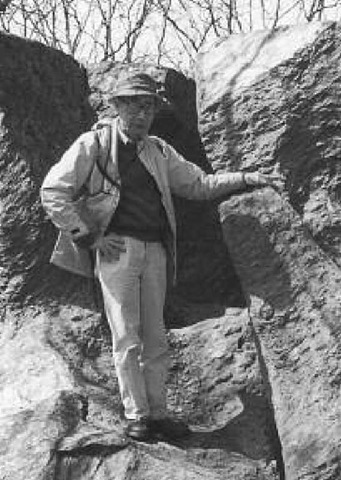(1928- ) Chinese Field Geologist, Petrologist
Many researchers have the reputation for being thorough in their work, but few are more thorough than E-An Zen. He is highly focused and tenacious in his projects. His geological career has concentrated on three areas of interest, mineralogy and petrology of marine sediments, granite petrology, and geological advocacy. Zen’s interest in marine sediments started with his dissertation on the Taconic sequence of sedimentary rocks in western Vermont and easternmost New York (see “Taconic Stratigraphic Names: Definitions and Synonymies” and “Time and Space Relationships of the Taconic Allochthon and Autochthon,” for example). This work could have been simply a mapping exercise as was common at the time. It may have then led to a career of regional Appalachian geology. However, Zen was not satisfied with the status quo. He studied modern marine sediments that were recovered from the Peru-Chile trench to better understand those comparable sedimentary rocks in the Taconics as described in “Mineralogy and Petrology of Marine Bottom Sediment Samples off the Coast of Peru and Chile.” His geo-chemical work on these rocks also led him to an interest in the thermodynamics of clay minerals.
His position with the U.S. Geological Survey led Zen to work in the Pioneer Mountains of southwestern Montana and introduced him to his second main area of interest, granite magma, and granite batholiths. He studied granitic plutons from there all the way to southern Alaska, devising methods to determine depths of emplacement through mineral chemistry. These data in turn allowed him to evaluate the uplift and erosion rates for the entire western United States. This interest also led Zen to help organize and run parts of two Hutton international conferences on granite emplacement. His papers “Using Granite to Image the Thermal State of the Source Terrane” and “Plumbing the Depths of Batholiths” are two summaries of this work. He is still working to determine thermal budgets for granite emplacement.
His third area of interest is public advocacy for the science of geology, which he began later in his career. Once again he attacked the project with the same zest that he had for his research projects. Primarily using the forum of GSA Today, Zen attempted to educate the educators about global sustainability and recipes for how to live in harmony with our planet. In collaboration with allison r. palmer, Zen wrote a series of articles entitled “Engaging ‘my neighbor’ in the Issue of Sustainability,” Parts II, V, IX, X, and XII. Once again his commitment and doggedness propelled him to the forefront of the movement and he was named to several very important committees at the National Academy of Science and National Research Council.
E-An Zen shows weathering features on a rock exposure in Great Falls National Park in northern Virginia
E-An Zen was born on May 31, 1928, in Peking, China. He immigrated to the United States as a teenager soon after World War II. He attended Cornell University, New York, and earned a bachelor of arts degree in geology in 1951. He entered Harvard University as a graduate student the same year and earned a master of arts and a Ph.D. in 1951 and 1955, respectively. His dissertation was on the petrology and stratigraphy of the Taconic Allochthon in western Vermont. He was a research fellow and associate at the Woods Hole Oceanographic Institution from 1955 through 1958, where he studied the mineralogy of modern marine sediments recovered from the Peru-Chile trench. Zen was a visiting assistant professor at the University of North Carolina at Chapel Hill in 1958-1959 before becoming a geologist and research geologist with the U.S. Geological Survey from 1959 to 1990. During that time he held a visiting professorship at California Institute of Technology, 1962-1963, a Crosby visiting professorship at Massachusetts Institute of Technology in 1972, a Harry Hess visiting fellowship at Princeton University in 1981, and a visiting fellowship at the Australian National University in 1991. In 1990, Zen became a scientist emeritus at the U.S. Geological Survey and an adjunct professor at the University of Maryland, positions he still holds today.
E-An Zen has published 115 articles to date in international journals, professional volumes, and U.S. Geological Survey reports and maps. He also published some 23 articles on geology and society. Zen was also an editor of an important volume entitled Studies of Appalachian Geology, Northern and Maritime. He has received numerous honors and awards for his research. He is a member of the National Academy of Science (1976- ) and a fellow of both the American Academy of Arts and Sciences and the American Association for the Advancement of Science. He was awarded the Arthur Day Medal from the Geological Society of America in 1986, the Roebling Medal from the Mineralogical Society of America in 1991, and the Major John Sacheverell Coke Medal from the Geological Society of London in 1992. He also received the 1995 Thomas Jefferson Medal from the Virginia Museum of Natural History.
Zen has performed outstanding service to the geological profession. He served on evaluating committees for California Institute of Technology, Harvard University, and Princeton University. He served on the National Research Council, the Scholarly Studies Committee for the Smithsonian Institution, the U.S. Committee on Geodynamics and on Geochemistry. He served as a member and officer for committees for the Geological Society of America and Mineralogical Society of America too numerous to mention. In addition, he served on the Committee on Human Rights and the Committee on Transition to Sustainability at the National Academy of the Sciences and the National Committee on Science Education Standards and Assessment at the National Research Council in 1992.

